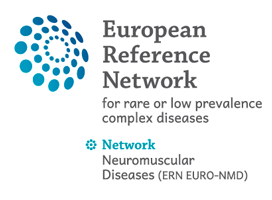Clinical Genetics, volume 106, issue , pages 13-26
Best practice guidelines on genetic diagnostics of facioscapulohumeral muscular dystrophy: Update of the 2012 guidelines.
Authors:
Emiliano Giardina 1 2 , Pilar Camaño 3 4 , Sarah Burton-Jones 5 , Gina Ravenscroft 6 , Franclo Henning 7 , Frederique Magdinier 8 , Nienke van der Stoep 9 , Patrick J van der Vliet 10 , Rafaëlle Bernard 8 11 , Pedro J Tomaselli 12 , Mark R Davis 13 , Ichizo Nishino 14 15 , Piraye Oflazer 16 , Valerie Race 17 , Venugopalan Y Vishnu 18 , Victoria Williams 19 , Cláudia F R Sobreira 12 , Silvere M van der Maarel 10 , Steve A Moore 20 , Nicol C Voermans 21 , Richard J L F Lemmers 10
1
Genomic Medicine Laboratory UILDM, IRCCS Fondazione Santa Lucia, Rome, Italy.
2
Department of Biomedicine & Prevention, Tor Vergata University of Rome, Rome, Italy.
3
Molecular Diagnostics Platform, Biogipuzkoa Health Research Institute, Hospital Universitario Donostia, San Sebastián, Spain.
4
CIBERNED, CIBER, Spanish Ministry of Science & Innovation, Carlos III Health Institute, Madrid, Spain.
5
South West Genomics Laboratory Hub, Southmead Hospital, Bristol, UK.
6
Harry Perkins Institute of Medical Research, University of Western Australia, Nedlands, Western Australia, Australia.
7
Division of Neurology, Department of Medicine, Faculty of Medicine and Health Sciences, Stellenbosch University, Cape Town, South Africa.
8
Aix Marseille Univ, INSERM, Marseille Medical Genetics, Marseille, France.
9
Department of Clinical Genetics, Leiden University Medical Center, The Netherlands.
10
Department of Human Genetics, Leiden University Medical Center, The Netherlands.
11
Centre Hospitalier Universitaire Timone Adultes, Biogénopôle, Service de Génétique Médicale, Marseille, France.
12
Department of Neurosciences, Division of Neurology, Ribeirao Preto Medical School, University of São Paulo, Ribeirão Preto, Brazil.
13
Department of Diagnostic Genomics, PathWest Laboratory Medicine, Perth, Western Australia, Australia.
14
Department of Neuromuscular Research, National Institute of Neuroscience, National Center of Neurology and Psychiatry (NCNP), Tokyo, Japan.
15
Department of Genome Medicine Development, Clinical Genome Analysis, Medical Genome Center (MGC), National Center of Neurology and Psychiatry (NCNP), Tokyo, Japan.
16
Department of Neurology, Koç University Hospital Muscle Center, Koç University Medical Faculty, Istanbul, Turkey.
17
Clinical Laboratory Geneticist, Human Genetics, UZ Leuven, Leuven, Belgium.
18
Department of Neurology, All India Institute of Medical Sciences (AIIMS), Delhi, India.
19
EMQN CIC, Manchester, UK.
20
Senator Paul D. Wellstone Muscular Dystrophy Specialized Research Center, Department of Pathology, Roy J. And Lucille A. Carver College of Medicine, The University of Iowa, Iowa City, Iowa, USA.
21
Department of Neurology, Radboud university medical center, Nijmegen, The Netherlands.
Abstract
The gold standard for facioscapulohumeral muscular dystrophy (FSHD) genetic diagnostic procedures was published in 2012. With the increasing complexity of the genetics of FSHD1 and 2, the increase of genetic testing centers, and the start of
clinical trials for FSHD, it is crucial to provide an update on our knowledge of the
genetic features of the FSHD loci and renew the international consensus on the
molecular testing recommendations. To this end, members of the FSHD European
Trial Network summarized the evidence presented during the 2022 ENMC meeting
on Genetic diagnosis, clinical outcome measures, and biomarkers. The working group additionally invited genetic and clinical experts from the USA, India, Japan, Australia, South-Africa, and Brazil to provide a global perspective. Six virtual meetings were organized to reach consensus on the minimal requirements for genetic confirmation of FSHD1 and FSHD2. Here, we present the clinical and genetic features of FSHD,
specific features of FSHD1 and FSHD2, pros and cons of established and new tech-
nologies (Southern blot in combination with either linear or pulsed-field gel electrophoresis, molecular combing, optical genome mapping, FSHD2 methylation analysis and FSHD2 genotyping), the possibilities and challenges of prenatal testing, including pre-implantation genetic testing, and the minimal requirements and recommendations for genetic confirmation of FSHD1 and FSHD2. This consensus is expected to contribute to current clinical management and trial-readiness for FSHD.

